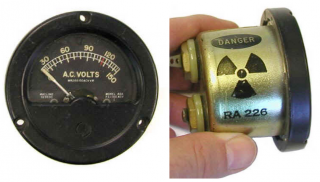Radionuclide Basics: Radium
Radium (chemical symbol Ra) is a naturally occurring radioactive metal. Radium is a radionuclide formed by the decay of uranium and thorium in the environment. The most common isotopesA form of an element that has the same number of protons but a different number of neutrons in the nucleus, giving it a different atomic mass. For example, uranium has thirty-seven different isotopes, including uranium-235 and uranium-238. of radium are Ra-226 and Ra-228. Radium-226 is part of the uranium decay seriesThe series of decays or transformations that radionuclides go through before reaching a stable form. For example, the decay chain that begins with Uranium-238 culminates in Lead-206, after forming intermediates such as Uranium-234, Thorium-230, Radium-226, and Radon-222. Also called the "decay series.". Radium-228 and Ra-224 are part of the thorium decay series. All isotopes of radium are radioactive. Radium decays to produce radon gas.
Radium in the Environment
In the natural environment, radium occurs at trace levels in virtually all rock, soil, water, plants and animals.
In areas where radium concentrations in rocks and soils are higher, the groundwater also typically has relatively higher radium content. Milling of uranium concentrates radium in the tailings. Uranium mining also results in higher levels of radium in nearby water. Radium may concentrate in fish and other aquatic animals. Plants and vegetation may take up radium from the soil.
Radium Sources
Everyone has some exposure to radium because it is naturally occurring in the environment. Individuals may be exposed to higher levels of radium if they live in an area where there are higher levels of radium in rock and soil. Radium concentrations in food and air are very low.
The concentration of radium in drinking water is generally low, but some regions have higher concentrations due to local geology. The amount of radium allowed in drinking water from community water systems is regulated. Private wells are not regulated.
In some geologic formations, oil and gas production can concentrate radium, often in pipe scale. Working in a uranium mine or in a plant that processes ore can lead to higher exposures. Phosphate rocks typically contain slightly higher levels of both uranium and radium and can raise exposures in phosphate mining areas.

Historically, radium was used in medical treatments and devices and for passive illumination of aircraft gauges. Contact your state radiation control program if you find such a device.
Radium and Health
Chronic exposure to high levels of radium can result in an increased incidence of bone, liver or breast cancer.
As radium decays it creates a radioactive gas, radon. Radon is common in many soils and can collect in homes and other buildings. Radon is the second leading cause of lung cancer in the United States. Learn more about radon.
